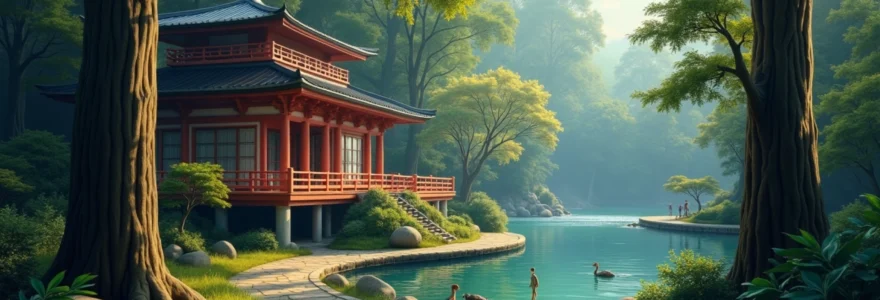In today’s hyperconnected world, finding true silence and disconnection has become a luxury. The constant barrage of notifications, emails, and social media updates can leave you feeling overwhelmed and disconnected from yourself. Fortunately, there are still places around the globe where you can step away from the digital noise and reconnect with what truly matters. These destinations offer more than just a break from technology; they provide an opportunity for deep introspection, mindfulness, and a chance to reset your mental and emotional state.
Digital detox destinations: analyzing global unplugged retreats
Digital detox retreats have gained significant popularity in recent years as people seek respite from the constant connectivity of modern life. These retreats offer a structured environment where participants voluntarily give up their digital devices for a set period, typically ranging from a weekend to several weeks. The goal is to break the cycle of digital dependence and rediscover the joys of analog living.
One of the most renowned digital detox destinations is Camp Grounded in California. This adult summer camp prohibits all digital devices, work talk, and even watches. Instead, participants engage in activities like archery, arts and crafts, and stargazing. The emphasis is on playfulness and human connection, encouraging attendees to rediscover their inner child and forge meaningful relationships without the barrier of screens.
In Europe, the Time to Log Off retreats offer a similar experience with a focus on mindfulness and well-being. These retreats, held in various scenic locations across the continent, combine digital detox with yoga, meditation, and outdoor activities. Participants report improved sleep, reduced anxiety, and a renewed sense of creativity after their unplugged experience.
Disconnecting from our devices allows us to reconnect with ourselves and the world around us in profound ways.
Mindfulness-focused travel: techniques and locations
Mindfulness travel goes beyond simply turning off your phone; it’s about cultivating a state of present-moment awareness throughout your journey. This approach to travel can transform even familiar destinations into opportunities for deep reflection and personal growth. Many locations around the world now cater specifically to mindful travelers, offering environments and practices that support this intentional way of experiencing the world.
Vipassana meditation centers: silent retreats in india and beyond
Vipassana, which means “to see things as they really are,” is an ancient meditation technique that has gained global popularity. Vipassana centers offer 10-day silent retreats where participants engage in intensive meditation practice without speaking, reading, writing, or any form of communication. These retreats are held in various locations worldwide, but the most authentic experience can be found in India, the birthplace of this technique.
The Dhamma Giri Vipassana Center in Igatpuri, Maharashtra, is one of the largest and most established Vipassana centers in India. Set against the backdrop of the Western Ghats, this center provides a serene environment for deep introspection. Participants spend their days in silent meditation, breaking only for simple vegetarian meals and brief rest periods. The challenging nature of the retreat often leads to profound personal insights and a heightened sense of self-awareness.
Zen buddhist temples: kyoto’s ryoan-ji and kinkaku-ji experience
Kyoto, the ancient capital of Japan, is home to numerous Zen Buddhist temples that offer visitors a glimpse into a world of mindfulness and contemplation. Two of the most renowned temples, Ryoan-ji and Kinkaku-ji, provide distinct yet equally profound experiences for mindful travelers.
Ryoan-ji is famous for its rock garden, a minimalist arrangement of rocks and raked gravel that embodies the Zen principle of simplicity. Visitors are encouraged to sit in silent contemplation, allowing the garden’s subtle beauty to inspire deep reflection. The act of shikantaza , or “just sitting,” is a core practice in Zen Buddhism that visitors can experience firsthand.
Kinkaku-ji, also known as the Golden Pavilion, offers a different kind of mindfulness experience. Its striking gold-leaf exterior reflects beautifully in the surrounding pond, creating a scene of ethereal beauty. While more visually stimulating than Ryoan-ji, Kinkaku-ji encourages visitors to practice mindful observation, focusing on the interplay of light, water, and architecture.
Mindfulness apps integration: headspace travel mode for jetsetters
For those who can’t completely disconnect during their travels, mindfulness apps offer a compromise. Headspace, a popular meditation app, has introduced a “Travel Mode” specifically designed for jetsetters. This feature provides guided meditations tailored to different aspects of travel, from dealing with flight anxiety to adjusting to new time zones.
The app’s travel-specific content includes exercises for mindful eating (particularly useful when experiencing new cuisines), walking meditations for exploring new cities, and sleep casts to help you relax in unfamiliar accommodations. By integrating these practices into your journey, you can maintain a sense of mindfulness even in bustling urban environments or during hectic travel days.
Nature-based mindfulness: forest bathing in japan’s aokigahara
Forest bathing, or shinrin-yoku in Japanese, is a practice that involves immersing oneself in the atmosphere of the forest. This technique, developed in Japan in the 1980s, has been scientifically proven to reduce stress, improve mood, and boost overall well-being. While forest bathing can be practiced in any natural setting, Japan’s Aokigahara forest offers a uniquely powerful experience.
Located at the base of Mount Fuji, Aokigahara is known for its dense foliage and eerily quiet atmosphere. The forest’s thick canopy and volcanic soil create an environment where sound is naturally muffled, providing an ideal setting for deep introspection and mindfulness practice. Guided forest bathing sessions in Aokigahara typically involve slow, mindful walks through the forest, engaging all five senses to fully absorb the natural surroundings.
Forest bathing is not about exercise or reaching a destination; it’s about being present in nature and allowing it to wash over you.
Off-grid adventures: remote locations for Tech-Free living
For those seeking a more extreme disconnection, off-grid adventures offer the opportunity to live completely free from modern technology, if only for a short time. These experiences often involve traveling to remote locations where infrastructure is minimal, and nature takes center stage. Off-grid travel can be challenging, but it offers unparalleled opportunities for self-reliance, personal growth, and a deep connection with the natural world.
Tristan da cunha: life on earth’s most isolated inhabited island
Tristan da Cunha, a British Overseas Territory in the South Atlantic Ocean, holds the title of the most remote inhabited island on Earth. With a population of just over 250 people and no airport, the island is accessible only by a week-long boat journey from Cape Town, South Africa. Visitors to Tristan da Cunha experience a way of life largely untouched by modern conveniences.
The island has limited internet access and no cell phone service, forcing visitors to adapt to a slower, more deliberate pace of life. Activities on the island include hiking the volcanic peak, observing unique wildlife like the Tristan albatross, and engaging with the tight-knit local community. A stay on Tristan da Cunha offers a rare opportunity to experience life as it might have been a century ago, free from the distractions of the digital world.
Alaska’s bush communities: disconnecting in the last frontier
Alaska’s vast wilderness is home to numerous “bush” communities, small settlements accessible only by air or water. These communities, often populated by a mix of Native Alaskans and those seeking an alternative lifestyle, offer visitors a chance to experience life off the grid in one of the world’s last great wildernesses.
Villages like Wiseman, located north of the Arctic Circle, provide a glimpse into a life dictated by the harsh realities of the Alaskan environment. Visitors can participate in traditional subsistence activities like hunting, fishing, and foraging, learning valuable skills of self-reliance. The absence of reliable cell service and limited electricity in many of these communities naturally foster a tech-free environment, allowing for deep immersion in the natural world and local culture.
Mongolia’s ger camps: nomadic living without modern amenities
Mongolia’s vast steppes offer a unique opportunity to experience nomadic living in traditional ger (yurt) camps. These round, felt-covered dwellings have been used by Mongolian nomads for centuries and provide a comfortable yet basic accommodation in the heart of the wilderness. Staying in a ger camp allows visitors to disconnect from modern amenities and experience the simplicity of nomadic life.
Activities in ger camps often include horseback riding, archery, and learning traditional crafts. Evenings are spent around the campfire, sharing stories and gazing at the star-filled sky unobstructed by light pollution. The absence of electricity and modern conveniences in many ger camps naturally creates an environment free from digital distractions, allowing visitors to fully immerse themselves in the rhythms of nomadic life.
Urban oases: finding tranquility in bustling metropolises
While remote locations offer obvious opportunities for disconnection, it’s also possible to find pockets of tranquility within bustling urban environments. Many cities have recognized the need for spaces that allow residents and visitors to escape the constant stimulation of urban life, creating urban oases that provide a respite from the digital world.
In Tokyo, one of the world’s most densely populated cities, the Shinjuku Gyoen National Garden offers 58 hectares of green space in the heart of the metropolis. The garden’s strict no-alcohol and limited-technology policies create an environment of peace and reflection amidst the urban chaos. Visitors can practice mindfulness while strolling through traditional Japanese landscapes, including a formal garden, a tea house, and tranquil water features.
New York City’s High Line, an elevated park built on a former railway line, provides another example of an urban oasis. The park’s design incorporates native plantings and quiet seating areas, offering visitors a chance to disconnect from the city’s frenetic energy. Regular meditation and yoga classes held on the High Line further encourage mindful engagement with the urban environment.
In London, the Barbican Conservatory offers a surprising tropical retreat within the brutalist architecture of the Barbican Centre. This hidden gem houses over 2,000 species of tropical plants and trees, creating a lush environment that feels worlds away from the city outside. The conservatory’s peaceful atmosphere and limited phone reception make it an ideal spot for urban dwellers seeking a moment of disconnection.
Eco-retreats: sustainable sanctuaries for mental reset
Eco-retreats combine the benefits of digital detox with a focus on environmental sustainability, offering guests a chance to reconnect with nature while minimizing their ecological footprint. These retreats often incorporate sustainable building practices, renewable energy sources, and locally sourced organic food, creating an environment that nourishes both body and soul.
Costa rica’s osa peninsula: biodiversity and disconnection
The Osa Peninsula, located in southwestern Costa Rica, is one of the most biodiverse regions on Earth. This remote area, largely untouched by development, is home to several eco-lodges that offer a perfect blend of luxury and sustainability. Lapa Rios, for example, is set within a 1,000-acre private nature reserve and operates entirely off the grid.
Guests at Lapa Rios can disconnect from technology while immersing themselves in the surrounding rainforest. Activities include guided nature walks, waterfall swimming, and wildlife observation. The absence of TVs and limited Wi-Fi encourage guests to engage fully with their environment, fostering a deep sense of connection with nature.
Australia’s daintree ecolodge: ancient rainforest immersion
Nestled in the heart of the Daintree Rainforest, the world’s oldest living rainforest, the Daintree Ecolodge offers a unique opportunity to disconnect in an environment of unparalleled natural beauty. The lodge’s 15 eco-friendly bayans (treehouses) are designed to blend seamlessly with the surrounding forest, minimizing environmental impact while maximizing guest immersion in nature.
Activities at the Daintree Ecolodge focus on connecting with the ancient rainforest and its indigenous heritage. Guests can participate in guided walks with aboriginal elders, learning about traditional plant use and Dreamtime stories. The lodge’s commitment to sustainability extends to its use of solar power, rainwater harvesting, and a policy of minimal waste, allowing guests to experience luxury with a clear conscience.
Sweden’s treehotel: architectural marvels in nature’s embrace
The Treehotel in Swedish Lapland offers a unique take on the eco-retreat concept, combining cutting-edge design with a deep respect for nature. Each of the hotel’s seven treehouses is a work of art, ranging from the reflective “Mirrorcube” to the UFO-shaped room suspended in the pines. Despite their modern design, these rooms are built using sustainable materials and construction methods that minimize impact on the surrounding forest.
Guests at the Treehotel are encouraged to disconnect from technology and reconnect with nature through activities like foraging, snowshoeing, and observing the Northern Lights. The hotel’s location in the boreal forest, far from light pollution and urban noise, creates an ideal environment for mindfulness and reflection.
Bhutan’s Carbon-Negative tourism: High-Value, Low-Impact travel
Bhutan, known for its commitment to Gross National Happiness, offers a unique approach to eco-tourism. The country’s “High Value, Low Impact” tourism policy limits the number of visitors while ensuring that tourism benefits local communities and preserves the natural environment. Bhutan is the world’s only carbon-negative country, absorbing more carbon than it emits.
Visitors to Bhutan can stay in eco-lodges that blend traditional Bhutanese architecture with modern sustainability practices. Many of these lodges, such as Gangtey Lodge in the Phobjikha Valley, offer digital detox programs that combine meditation, hiking, and cultural immersion. The country’s pristine environment and deeply spiritual culture provide an ideal setting for disconnecting from technology and reconnecting with oneself.
Digital detox travel planning: strategies and resources
Planning a digital detox trip requires a different approach from typical vacation planning. While the goal is to disconnect, some initial preparation using digital tools can help ensure a smooth and truly unplugged experience. Here are some strategies and resources to consider when planning your digital detox journey.
Offline navigation tools: maps.me and OsmAnd for Tech-Lite exploration
One of the biggest challenges of traveling without constant internet access is navigation. Fortunately, several apps allow you to download detailed maps for offline use. Maps.me and OsmAnd are two popular options that provide comprehensive offline mapping capabilities.
Before your trip, download the maps for your destination while you still have a reliable internet connection. These apps allow you to mark points of interest, plan routes, and navigate without needing to be online. By preparing your navigation tools in advance, you can confidently explore your destination without relying on constant connectivity.
Analog photography revival: documenting journeys without screens
In the age of smartphone photography, rediscovering the art of analog photography can be a rewarding way to document your travels without relying on digital devices. Film cameras, whether simple point-and-shoot models or more advanced SLRs, offer a different way of seeing and capturing the world around you.
The limitations of film photography – a finite number of shots, no instant review – can encourage more thoughtful and deliberate image-making. This mindful approach to photography aligns well with the goals of digital detox travel, encouraging you to be fully present in each moment rather than constantly seeking the perfect Instagram shot.
Tech-free travel insurance: policies for Off-Grid adventures
When planning an off-grid or digital detox trip, it’s important to consider travel insurance that covers the unique aspects of these adventures. Look for policies that provide comprehensive coverage for remote locations, including emergency evacuation if necessary. Some insurers offer specific policies for adventure or eco-tourism that may be well-suited to digital detox travel.
Be sure to carefully review the terms of any insurance policy, paying particular attention to coverage for
activities that may not be covered by standard policies. For example, some insurers may have exclusions for certain off-grid activities or may require additional coverage for trips to very remote locations.
When selecting a policy, consider factors such as:
- Coverage for adventure activities (hiking, kayaking, etc.)
- Emergency evacuation from remote areas
- Coverage for lost or damaged gear
- Trip cancellation/interruption due to natural events in remote areas
By carefully considering your insurance needs and choosing an appropriate policy, you can embark on your digital detox adventure with peace of mind, knowing you’re protected against unforeseen circumstances.
Proper planning and preparation are key to ensuring a smooth and truly unplugged travel experience.
As you plan your digital detox journey, remember that the goal is not just to escape technology, but to create space for meaningful experiences and personal growth. By choosing the right destination, preparing adequately, and approaching your trip with an open mind, you can unlock the transformative power of unplugged travel.


